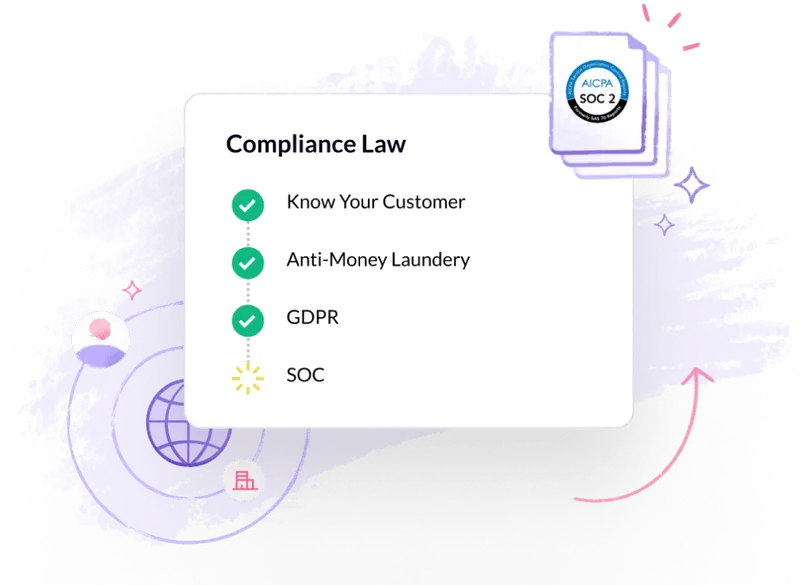Financial institutions are considered the backbone of any global economic system. However, criminals find these institutions an enticing target. Due to the rise of online money-management platforms, money laundering has become a global concern. An estimated 2-5% of global GDP, or USD 800 billion to 2 trillion, is laundered annually. Naturally, following Anti-Money Laundering (AML) regulations is essential for preventing money laundering and keeping the financial system secure.
Successful AML case management is essential to any effective AML compliance program. Handling a large number of notifications and investigations might become difficult and time-consuming for financial institutions.
This article delves into the world of AML case management, looking at best practices and showing how automation can speed up processes for you to concentrate on what counts—detecting and preventing financial crime.
What is AML case management?
For financial institutions, AML case management translates to monitoring and investigating any suspicious activity or potential money laundering cases. Several steps are involved, including:
- Orientation of new clients: Customers’ identities and risk profiles can be better assessed by using Know Your Customer (KYC) protocols.
- Transaction monitoring: Transaction monitoring looks for suspicious activity in client transactions based on established criteria and circumstances. Additionally, it involves recognizing transactions that may require ongoing monitoring and customer due diligence due to possible suspicious activities.
- Notification creation and examination: This involves creating notifications for suspicious financial transactions and thoroughly investigating to check they are valid concerns.
- Record-keeping and final reports: Occasionally, reporting suspicious activity to regulatory bodies and keeping detailed records of investigations are required.
Financial institutions need AML compliance as it aids with:
- Halting terrorist financing and money laundering: AML is essential in stopping money laundering by spotting and halting dubious transactions and reporting suspicious activities.
- Reducing regulatory penalties: Huge fines and harm to the reputation of a financial institution can result from breaking AML rules.
- Maintaining a good customer experience: Unwanted delays in customer onboarding and transactions can be prevented by implementing effective AML procedures.
Who is an AML case manager?
Specialists in financial crime who oversee the AML case management system are known as AML case management solution managers. Tasks like reviewing AML system-generated transaction notifications fall under their purview. The following are some activities that AML case managers perform:
- Launching probes into questionable transactions
- Collecting and analyzing more data from customers
- Recording the results and reasoning behind an investigation
- Notifying the appropriate regulatory authorities, such as law enforcement or regulators, of exceptionally dangerous cases
- Maintaining fluency in anti-money laundering rules and guidelines
To prevent the laundering of funds or the funding of other terrorism financing, financial institutions rely on their compliance team and AML case managers or AML compliance officers to ensure adherence to AML requirements.
Why is AML case management important?
For financial institutions, an effective AML case management process is critical. More than just a formality, it provides practical advantages to strengthen your company’s credibility, efficiency, and legal position. Here’s why it matters so much:
- Improves performance while cutting cost: Time and resources are wasted when each transaction alert has to be manually investigated. A defined and automated AML case management system makes the investigation more manageable. Automated risk-scoring prioritizes notifying high-risk warnings so that investigators can focus on situations with a higher chance of suspicious conduct Hence, your organization can save money while conducting thorough investigations.
- Reduces false positives and improves accuracy: False positive alerts or warnings triggered by innocuous activity, are high in traditional AML case management systems and can create a lot of noise while being of little significance. A case management software that uses machine learning may sift through mountains of data in search of trends that may identify as questionable or fraudulent transactions. Consequently, the research procedure becomes more precise and efficient as the number of false positives is greatly diminished.
- Increases regulatory compliance: Financial regulatory authorities and agencies impose stringent AML rules on financial institutions. Robust case management systems guarantee a transparent audit trail, recording all SAR filings, KYC processes, and investigations to prove your dedication toward compliance and keep you out of legal trouble.
- Protects your reputation: The reputation of your financial institution can be damaged if you fail to prevent money laundering activities adequately. Customers’ faith may take a nosedive if the media broadcast AML infractions of your company. By taking a proactive stance against financial crimes, a solid case management system shows you are conscious of your reputation and customers’ faith.
- Prevents financial risks: Money laundering often goes hand in hand with other financial crimes like fraud and terrorism financing. You can avoid financial losses by spotting suspicious activity early with the help of an advanced AML case management system. This mitigates the dangers of illegal actions to your institution’s finances.
- Fosters stronger customer relations: A well-managed AML case management process aids legal clients by avoiding extra hassle. Investigations become efficient and reduce transaction and customer onboarding delays. It is also a testament to your dedication to offering a hassle-free banking experience and cultivating great customer relationships.
Steps in AML Case Management

Let’s dive further into the steps of AML case management:
Customer onboarding
In the AML case management system, the initial phase is customer onboarding.
- KYC: One way to create a risk profile baseline is to check the client’s identification and background. Implementing comprehensive KYC processes helps find high-risk client profiles that need further investigation and due diligence.
- AML risk screening: It is essential to screen clients against government sanctions and watchlists to detect possible dangers connected to politically exposed persons (PEPs) or businesses and individuals affiliated with criminal activity.
Transaction monitoring
As part of transaction monitoring, we must look out for any unusual or suspicious conduct related to customer transactions using a set of predetermined scenarios and warning signs. Potential warning signs reporting suspicious customer behavior could consist of:
- Large or uncommon expenditures.
- Deals with jurisdictions or organizations posing a high danger.
- Transaction patterns that do not match.
- Identification of unwanted behavior.
AML case management systems monitor transactions and raise red flags, necessitating further investigation.
Alert generation and investigation
The quality of the investigation is the deciding factor for the success of any AML case management system. Here is a breakdown:
- Alert prioritization: Warning signs do not necessarily indicate danger. Immediate investigation of high-risk signals can be prioritized using a risk-based methodology.
- Investigation: For flagged transactions, AML case managers conduct investigations by collecting additional client data and examining the trends of such transactions.
- Suspicious activity detection: Detection of abnormal or suspicious transactions, such as higher amounts than usual, frequent transactions without proper purpose, and more.
- Enhanced due diligence: Extra caution should be taken in circumstances that pose a significant risk. For a fuller view of the customer’s actions, it’s necessary to collect supplementary data like income sources and the reason behind their business.
- Collaboration: Successful evidence collection and resolution of complicated cases often depend on efficient communication and cooperation between AML investigators, KYC teams, and law enforcement agencies.
Documentation and reporting
The key to keeping an audit trail intact and demonstrating compliance is thorough documentation, which includes the following:
- Keep detailed notes on all investigations, explaining the decisions and actions taken.
- Report suspicious activities, like money laundering, to regulatory bodies.
Best practices for AML case management
If you want to enhance your AML case management system, follow these guidelines:
- Implement a risk-based approach: Optimize the investigation process by focusing on high-risk warnings.
- Capitalize on technological advancements: Case management tools, data analysis capabilities, and automated alert prioritization are some of the features of AML case management software.
- Invest in training: Establish transparent and uniform protocols to thoroughly and efficiently investigate suspected conduct.
- Promote communication and collaboration: Maintain a consistent training program for AML investigators, including new regulations, best practices, and warning signs.
- Encourage open dialogue: To guarantee a comprehensive strategy for AML compliance, it is important to encourage open dialogue between AML investigators, KYC, compliance teams, and other departments.
Conventional approaches to AML case management might become ineffective when faced with an overwhelming number of fraud warnings and transactions, which is when automated monitoring systems become helpful.
Stay compliant with automated AML solutions

An AML software with Artificial Intelligence (AI) and Machine Learning (ML) can significantly boost accuracy and effectiveness. These solutions will help you manage the following issues:
- Reduce false positives: Utilizing AI and ML algorithms results in a decrease in false positives. These technologies analyze large datasets and identify patterns distinguishing suspicious and innocuous transactions.
- Prioritize alerts: To help investigators focus on the most critical cases, automated risk-scoring prioritizes high-risk warnings for rapid AML investigations, saving time.
- Improving data analysis: A good case management solution provides robust data analysis capabilities, making ongoing monitoring efficient by revealing hidden suspicious activities.
Strong anti-money laundering compliance programs have effective AML case management as their foundation. Simplifying the process, optimizing resources, and focusing on identifying and solving financial crime are all possible by utilizing automation and the best practices stated above. Please note that a good AML case management solution and a powerful anti-money laundering program serve to protect both your banking institution and the whole financial system.
Streamline operations, boost productivity, and guarantee adherence to AML rules with HyperVerge’s advanced AML case management system that can automate tasks. Sign up now!





